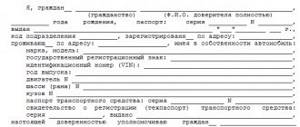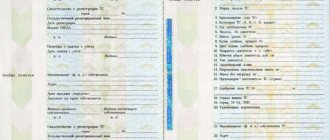It happens that a legal entity decides to purchase not a new car, but a used one. The reasons, within the framework of the question, are not so important.
This procedure of purchase and sale between individuals. and legal entities has many nuances associated with the acceptance of a vehicle on the balance sheet of a legal entity. We focus on the features of the procedure. We will tell you in this article how to avoid the risk of losing all the benefits from the transaction.
What documents are drawn up?
By virtue of clause 1, part 1, art. 161 of the Civil Code of the Russian Federation, a transaction for the purchase and sale of a vehicle, to which a legal entity is a party, is concluded, at a minimum, in simple written form. That is, it must be compiled:
- contract;
- act of acceptance and transfer.
At the request of the parties, the document can be certified by a notary . The notarial form of the transaction is not mandatory. But, if the document is signed by the specified official, then there will be more guarantees that unnecessary problems will not arise with the transaction.
What papers are required to complete the purchase and sale?
Purchasing act
This is a document that indicates that the organization (legal entity), on behalf of which its representative acts, acquired from an individual. a person purchasing a certain product, for example, made a purchase of a car. In this case, a car. Practice follows the following path: the parties enter into a procurement act containing all the essential conditions for the purchase and sale of a vehicle, and do not draw up the DCP itself.
Why is this happening:
- The fact is that the monetary policy cannot be a primary accounting document, in accordance with the Federal Law “On Accounting”.
- The procurement act meets all necessary requirements regarding reporting. If it contains information that should be in the DCT, then the act, in essence, becomes an agreement. At a minimum, simple written form is considered to be met.
- If the purchase act contains information about the transfer of the vehicle to the buyer and money to the seller, then there is no need to draw up an additional acceptance document.
Thus, the procurement act becomes the main document that evidences the completion of the transaction.
Agreement
As noted, it is not at all necessary to prepare a purchase and sale agreement if there is a well-drafted procurement act. If the DCP is drawn up, then it must contain the information referred to in Art. 454 Civil Code of the Russian Federation :
- about the seller and the buyer;
- about the product;
- about the cost.
The agreement is consensual. That is, it is valid not from the moment of exchange of values, but from the time the parties reach agreement on the terms of the transaction.
Read more about the rules for drawing up a written contract when a legal entity purchases a car from an individual here.
Certificate of acceptance and transfer of property
Elements of this document may be contained in the procurement act . If the parties did not take care of this, then the transfer deed indicates:
- information about the parties;
- about the subject of the contract and the price of the goods;
- about the specified shortcomings, if any;
- about accessories and documents that are transferred along with the vehicle.
Practice shows that the deed of acceptance and transfer is often not concluded even by individuals. All information is written down in the DCP. There are no questions at MREO.
Account cash warrant
A document in form No. KO-2 is issued if money is paid to the seller in cash . The form was approved by State Statistics Committee Resolution No. 88, which came into force in 1998.
Simply put, the seller is given this order, which he has the right to exchange for money. The amount will correspond to the price of the car.
Payment order and bank statement
These papers are needed to confirm that the cost of the vehicle has been paid by bank transfer.
- An order is an order, issued on behalf of an organization, for the bank to transfer a certain amount of funds to the seller of the car.
- A bank statement will indicate that the money has been debited from the buyer's account.
These are not all the documents that will be needed for the transaction. The following documents will also be needed:
- PTS – vehicle passport. This is a paper containing basic information about the car and its components and assemblies. From the PTS you can find out: what make and model the car is, what color, what VIN number and state registration plate. The PTS also contains information about what registration actions were carried out with the car previously.
- STS – car registration certificate. The document confirms that the car is registered with the traffic police to a certain owner. It is quite possible to do without this paper when concluding a transaction.
- Diagnostic card - a paper indicating that the car has passed technical inspection and is in good condition. The document is required to issue an MTPL policy.
When registering a car, you will need some more paperwork, but more on that later.
From our separate publications, you can learn how to correctly sell a vehicle from a legal entity to an individual, as well as read recommendations for individuals on how to correctly purchase a vehicle from an organization.
Sale of a car by an organization to an individual
Selling used cars occurs quite often in practice. A legal entity sells a vehicle that has reached the end of its useful life, and an individual gets the opportunity to obtain a vehicle at a reduced price. The procedure for citizens to purchase a vehicle owned by organizations is carried out in stages:
Attention! If you have any questions, you can chat for free with a lawyer at the bottom of the screen or call Moscow; Saint Petersburg; Free call for all of Russia
- A standard car purchase and sale agreement is drawn up, which specifies comprehensive information about the legal entity. This is the legal address, INN, its full name, details of the responsible person. According to the Civil Code of the Russian Federation, the contract must be in writing.
- An individual makes payments within the terms established by the contract. You can use the organization’s cash register and deposit funds against a receipt. Alternatively, the buyer can transfer the agreed amount to the company bank account specified in the car purchase agreement.
- After confirming the fact of payment for the purchased car, the citizen must check the technical condition of the car and its serviceability. Based on the inspection results, a vehicle acceptance certificate is drawn up.
From the editor: Which car color is the most practical? car color and road safety
The final stage of the transaction between a citizen and a legal entity is the receipt of documents for the vehicle. The vehicle must include a diagnostic card, a certificate confirming registration and an insurance contract. Having the documents in hand, the new owner must, within the deadlines established by the legislator, register the vehicle in his name and become the full owner. The registration procedure is standard - an application is written and documents according to the list are submitted to the state inspection department.
An organization that plans to independently sell a car issues an appropriate order. The order must indicate the essential terms of the upcoming transaction, which will be reflected in the vehicle purchase and sale agreement. As for the cost of the car, accounting data will not be enough. An expert is hired to assess the real price of the organization's property. The results of the conclusion will be the basis for putting the car up for sale.
Scheme for an organization purchasing a car from an ordinary motorist
How to buy a car for an organization from an individual? To buy a car you need to find a buyer . The easiest way is to open a popular message board on the Internet. Next you need to inspect the car, you can bargain. But these are all points that almost do not relate to the legal side of the issue. What needs to be done from a legal point of view?
Make a deal
The parties agree on the terms of the transaction.
One of the above documents is being prepared. As noted, the procurement act may contain all the essential terms of the transaction, then there is no need to draw up a contractual agreement.
The seller, being an individual, puts his signature on the document . Legal representative person - your autograph and an imprint of the company seal.
If the agreement is drawn up by a notary, then under its text there will be the signature and seal of the specified official.
We discussed in more detail all stages of the transaction when a legal entity purchases a car from an individual in a separate material.
Cash settlement
As noted, funds can be transferred:
- cash;
- by transfer to the seller's bank account.
Is there a legal limit on how much cash can be given?
The Central Bank of the Russian Federation in its instructions No. 3073-U (clause 5) explains that if we are talking about a purchase transaction between legal entities. and physical persons, then payment can be made in cash at any value of the goods. That is, there are no legal restrictions. If, for example, a car costs 1 million rubles, then the seller will receive, if desired, this entire amount in cash.
If an individual entrepreneur is involved in the transaction, then payment must be made by non-cash means if the cost of the goods exceeds 100 thousand rubles.
Acceptance of a vehicle onto the balance sheet of an enterprise
An important action, since failure to balance the car is a serious violation of the law . Goskomstat has developed special documents to formalize such a procedure. This:
- Form OS-1 – act of acceptance and transfer of fixed assets of production;
- Form OS-6 – inventory card.
Cars are considered to be the main means of production . Based on the following features:
- Long term use - more than 1 year.
- High cost - more than 40 thousand Russian rubles.
The procedure is as follows:
- A transfer deed is prepared, to which the PTS is attached.
- The act is signed by the members of the commission, which is formed by the head of the company.
- Next, the responsible person fills out the inventory card.
It is not always possible to form a commission. For example, the company is so small that it has less than three IT employees. In this case, the law allows you to limit yourself to imprinting a stamp on a document that establishes title - this, in most situations, is a procurement act.
Registration of a vehicle with the traffic police
On behalf of a legal entity, when registering it with the MREO, a representative holding a power of attorney acts. The document must give the attorney the following rights :
- representation of interests in the bodies of the State Traffic Safety Inspectorate;
- signing and submitting an application for vehicle registration;
- obtaining a new PTS or an old passport with changes made to it, STS, state registration plates.
The algorithm of actions is as follows:
- A representative of a legal entity is sent to the MREO with all the necessary papers:
- DCP or procurement act;
power of attorney;
- passport;
- PTS;
- OSAGO policy;
- a receipt for payment of the state duty, if the payment in favor of the state has not yet been paid.
The company’s constituent documents are also submitted to the MREO:
- charter;
- TIN, OGRN certificates (if issued);
- order on the appointment of a manager;
- extract from the Unified State Register of Legal Entities.
Next, all the necessary documents are issued to the attorney, who is obliged to transfer them to the management of the organization.
Vehicle purchase scheme
In order for a company to purchase a vehicle from an ordinary car owner, it is necessary to go through several stages according to the car purchase scheme. For a competent and legally clean transaction, it is recommended to involve a company lawyer in the registration process.
Main stages of purchase:
- Search for a seller. For the search, the company appoints a responsible person who searches for a suitable car that meets the company’s criteria. Notice boards, special sites for the sale of vehicles.
- Contact the car seller. The ad indicates the phone number or email of the seller at which the company contacts. It is worth weeding out dubious transaction options - registration through resellers, registration under a general power of attorney, if the original PTS is missing.
- Inspection of the vehicle and meeting with the seller. It is possible to meet with a group of trusted persons: the company’s accountant, technical consultant and the driver himself from the company. It is better if the owner brings the vehicle to the enterprise base for inspection. The share of the purchase and sale transaction is assigned by the responsible person.
- Checking transport documents.
- Setting the price for a car.
- Drawing up a purchase and sale agreement between a legal entity and an individual.
- Calculation of monetary value in favor of an individual.
- Receipt of the car and documents by the company.
From the editor: What to do if you get into an accident
Documentation of the transaction
In accordance with clause 1, part 1 of the Civil Code of the Russian Federation, a purchase and sale transaction between a legal entity and an individual is concluded in writing. All documents, at the request of the parties, can be certified by a notary, so the company will eliminate the risks of fraud on the part of the seller; a certified document also eliminates risks for the car owner.
What documents does an individual provide?
The following must be compiled:
- contract of sale. Must contain information about the transport, owner and company, the cost of transport is also indicated;
- act of acceptance and transfer. Sometimes the parties indicate the specifics of the transfer and acceptance certificate in the procurement act; if this is not the case, then information about the parties to the transaction, transport, price, identified transport deficiencies is indicated, all documents relating to the vehicle are listed;
- account cash warrant. This document is issued when cash is paid to the seller;
- payment order or bank statement if a non-cash payment is made with the seller.
Other documents for registration:
- Purchasing act. Sometimes only a purchase act is concluded without a sales contract, but it is recommended that all documents be completed to avoid problems.
- Vehicle passport.
- Diagnostic card.
- Vehicle registration certificate.
- Seller's passport.
- Certificates that there are no encumbrances or restrictions on transport.
- If the seller is married, then the consent of the spouse should be sought.
- Certificate of ownership of the vehicle.
SPI
Useful life is an indicator that makes it possible to understand how long the main means of production will generate income. SPI is necessary for making accounting entries .
The problem is that, in order to determine the useful life, documents are needed that make it possible to understand how long the machine “was in use” previously. Without this, it is impossible to establish SPI.
It would seem that nothing could be simpler: you need to open the PTS and look at the dates of registration of the vehicle with the traffic police . But the Ministry of Finance thinks differently. There are a number of letters on this matter. For example:
- 03-03-06/1/10056;
- 03-03-06/1/658.
The reason is simple: the fact of putting any dates on the title does not indicate that it was in these numbers that production depreciation of the car began.
Practice followed the following path: SPI for cars purchased in the name of organizations from individuals. persons are not determined . That is, the cars pass through the papers like new. This is not entirely correct, but no other way out was found.
Features of tax regimes: what does an entrepreneur need to know when buying a car?
After registration, an individual entrepreneur is not an ordinary individual, but an entity running his own business who:
- opens current accounts;
- pays taxes;
- takes out insurance;
- reports to tax authorities.
If an individual entrepreneur purchased a car for business activities, then it becomes an element of taxation. However, this process has its own characteristics, depending on the form and methods of purchase.
From the editor: Chassis design
If during state registration a person has chosen a simplified taxation system (STS Income minus expenses), then the purchased car can reduce the amount of tax payments. This opportunity applies if the vehicle was purchased for business activities, which can be documented
After purchase, tax payments and car maintenance costs will be added to the expenses.
If the entrepreneur is on the general taxation system (OSNO), then it is important to perform the following actions: write an order in your name, which will record that the vehicle is used exclusively for work and not in everyday life; when using a car, issue waybills, which will prove that the entrepreneur owns the car for business activities.. In fact, choosing OSNO is inconvenient for individual entrepreneurs, since after purchasing a car many questions and tasks arise regarding how to enter the costs of a car into expenses
In fact, choosing OSNO is inconvenient for individual entrepreneurs, since after purchasing a car many questions and tasks arise regarding how to include the cost of a car in expenses.
Registration of a car allows an entrepreneur to use it for his business and document expenses spent on operation in the vehicle maintenance category. This reduces the number of tax objects in which all payments are recorded.
For an individual entrepreneur, vehicle registration occurs in accordance with the general rules provided for individuals. However, there are no serious conditions for the vehicle to be used only for delivery or transportation, so it is possible to drive to perform other main activities.
In this case, all funds that will be spent on gasoline, oil, repairs and other automotive operations can be recorded as service and transportation expenses.
For reporting, the individual entrepreneur must bring supporting documents to the accounting department: receipts for payment for gasoline, use of paid parking, service stations, etc.
If a merchant bought a vehicle as an individual
An individual entrepreneur is an individual who is registered in the manner prescribed by regulations and carries out entrepreneurial activities. According to Art. 212 of the Civil Code, an individual entrepreneur is not a subject of property rights. Thus, the purchase of a vehicle is always for an individual.
The main difference arises when the purpose of using the car is determined. When operating a car for personal purposes, the individual entrepreneur does not report to the tax office the expenses for the vehicle, and on the income received from the sale he pays only 13% of personal income tax. For more information about whether you need to pay personal income tax and in what cases and how to reduce the amount or avoid the contribution, read this material.
The vehicle certificate can contain information that the owner of the car is an individual entrepreneur. For this purpose, the document contains a column “Special notes”.
VAT
Phys. persons do not pay VAT. This rule is contained in Art. 143 Tax Code of the Russian Federation. There will be no “input” VAT. But the tax will need to be charged if the company wants to resell the car (Article 146 of the Tax Code of the Russian Federation).
Exceptions (Article 154 of the Tax Code of the Russian Federation):
- Vehicles purchased for resale.
- Agricultural machinery contained in the list approved by the government (Decree No. 383 of May 16, 2001).
The VAT rate will be 10 or 18% (from 2021 - 20%).
Personal income tax and insurance premiums
In this area, the organization is completely relieved of any responsibilities . More details:
- Insurance premiums are not made because this is a sales transaction and not an employment relationship.
- The organization is not a tax agent for the transaction. Phys. the person is obliged to independently report on the fact of the sale of the vehicle and the amount of profit received; pay tax, which is 13%. Please remember that certain deductions apply.
Moreover, the company has no obligation to report that the transaction has, in principle, been completed. This should be done by the seller.











